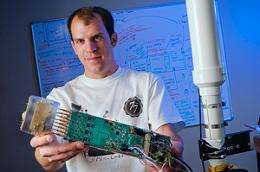Researcher develops new antenna to aid rural emergency workers

Emergency workers in rugged, rural areas may never lose a cell phone call again thanks to a new antenna developed by Montana State University researchers in collaboration with Advanced Acoustic Concepts, Inc.
Dropped calls when using a cell phone in rough terrain is a common problem that can be addressed by the MSU antenna, according to the developers.
The MSU antenna is considered a "smart" or "adaptive array" antenna because it uses a computer chip to automatically aim the message transmission beam in the right direction, chooses the most appropriate signal strength, optimizes the strength of transmitted beams and adapts to the environment. The automatic control allows users to communicate in rugged terrain while on the move. Unlike normal antennas, which broadcast in all directions simultaneously, smart antennas maintain a direct signal between individuals users, which could mean fewer dropped calls and the ability to move more data, such as streaming video.
With help from student teams, the researchers built and successfully tested a prototype under mobile use in rugged Montana terrain. First responders in Eastern Montana, firefighters in the wilderness, telecommunications providers in remote areas and soldiers in Afghanistan are among those who might use the MSU technology that's available now for licensing.
Unlike most commercial smart antennas that have a limited range of 120 degrees or less, the MSU antenna can rapidly process signals in a 360-degree range.
The MSU antenna can lock onto one signal and tune out unwanted signals, giving users a stronger, clearer, more reliable signal than they'd have otherwise. The MSU antenna can track and hold a signal even when the sender or receiver is moving. It is also capable of high bandwidth transmissions such as sending live video. Users might want to optimize communications by integrating the antenna with other antennas to form a "meshed" network in a back-country environment for emergency response or military operations.
The MSU antenna is a cylinder about three inches in diameter and a foot long. It weighs less than eight pounds.
"We designed this intentionally to be small. It could be used in many applications where having something small and light is very desirable," said Richard Wolff, Gilhousen Telecommunications Chair in MSU's Department of Electrical and Computer Engineering.
Aaron Traxinger, a research engineer at Advanced Acoustic Concepts and graduate student at MSU, said, "It's extremely easy to set up, and there are all sorts of ways to set up the software."
Traxinger started worked for Advanced Acoustic Concepts in Bozeman after earning his bachelor's degree from MSU. The antenna was his first assignment at his new job, Traxinger said.
Wolff said Yikun Huang, a research associate professor in electrical and computer engineering, came up with the idea for the antenna about five years ago. Turning the idea into reality involved six students during the spring semester and many more before that. Participants over the years have been MSU undergraduate students, graduate students and faculty members; industry partner Advanced Acoustic Concepts, and students who spent summers at MSU through a National Science Foundation program called Research Experiences for Undergraduates.
Funding for the project came from a variety of sources, including Advanced Acoustic Concepts, the Montana Board of Research and Commercialization Technology, the National Science Foundation and the U.S. Navy through the Small Business Innovation Research Program. Wolff's position as Gilhousen Chair was created thanks to a $5 million donation in 2001 from Karen and Klein Gilhousen, the co-founder of Qualcomm Inc., and a pioneer in the wireless field.
"The partnership between Advanced Acoustic Concepts and MSU has been a success for both private industry and the university," said Bob Testut, general manager of AAC's Montana operations. "The U.S. Navy acquires needed technology while MSU provides real world problems to the engineering students."
Provided by Montana State University


















